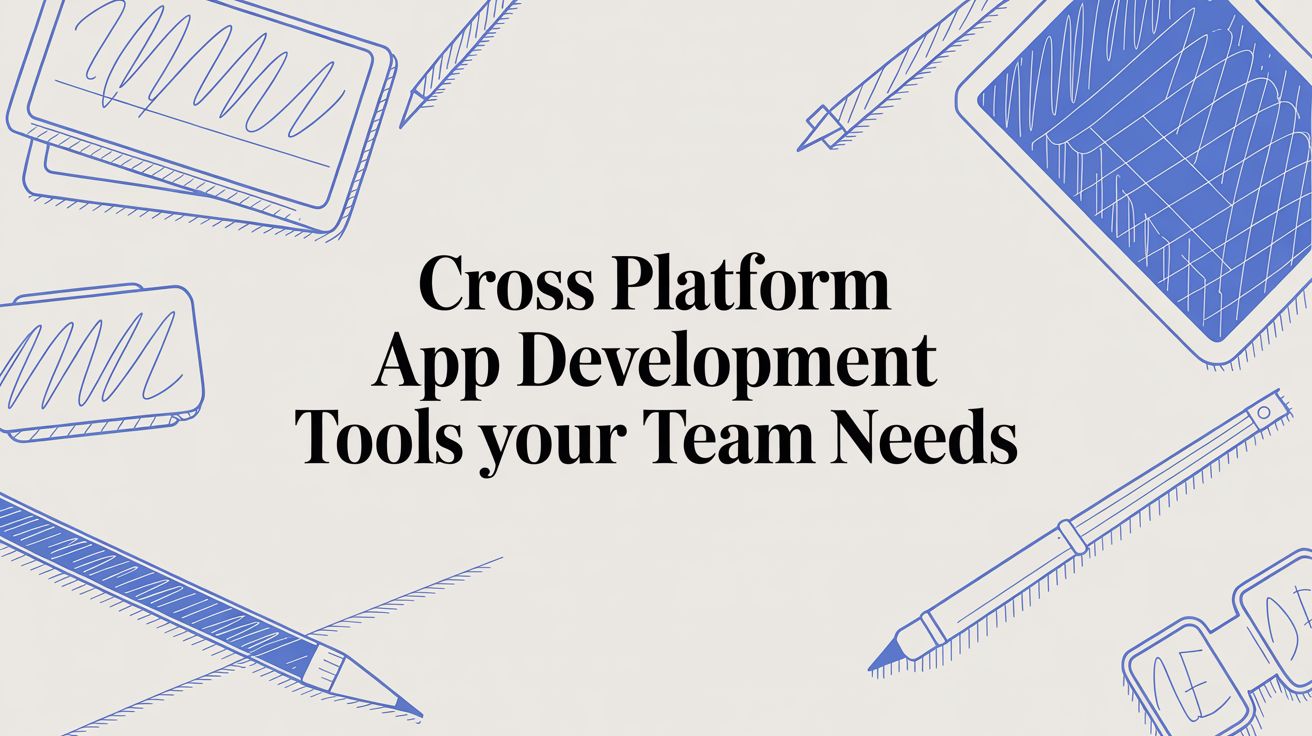
If you've ever dipped your toes into the world of app development, you’ve probably heard the terms 'native' and 'cross-platform' thrown around. But what exactly are cross-platform app development tools, and why are they such a big deal?
At their core, these tools are a bit like a universal translator. They let you write your app's code once and then deploy it on both iOS and Android, saving your team from the headache of building two completely separate apps from the ground up. This efficiency is why they’ve become so popular—it means getting to market faster with a much leaner budget.
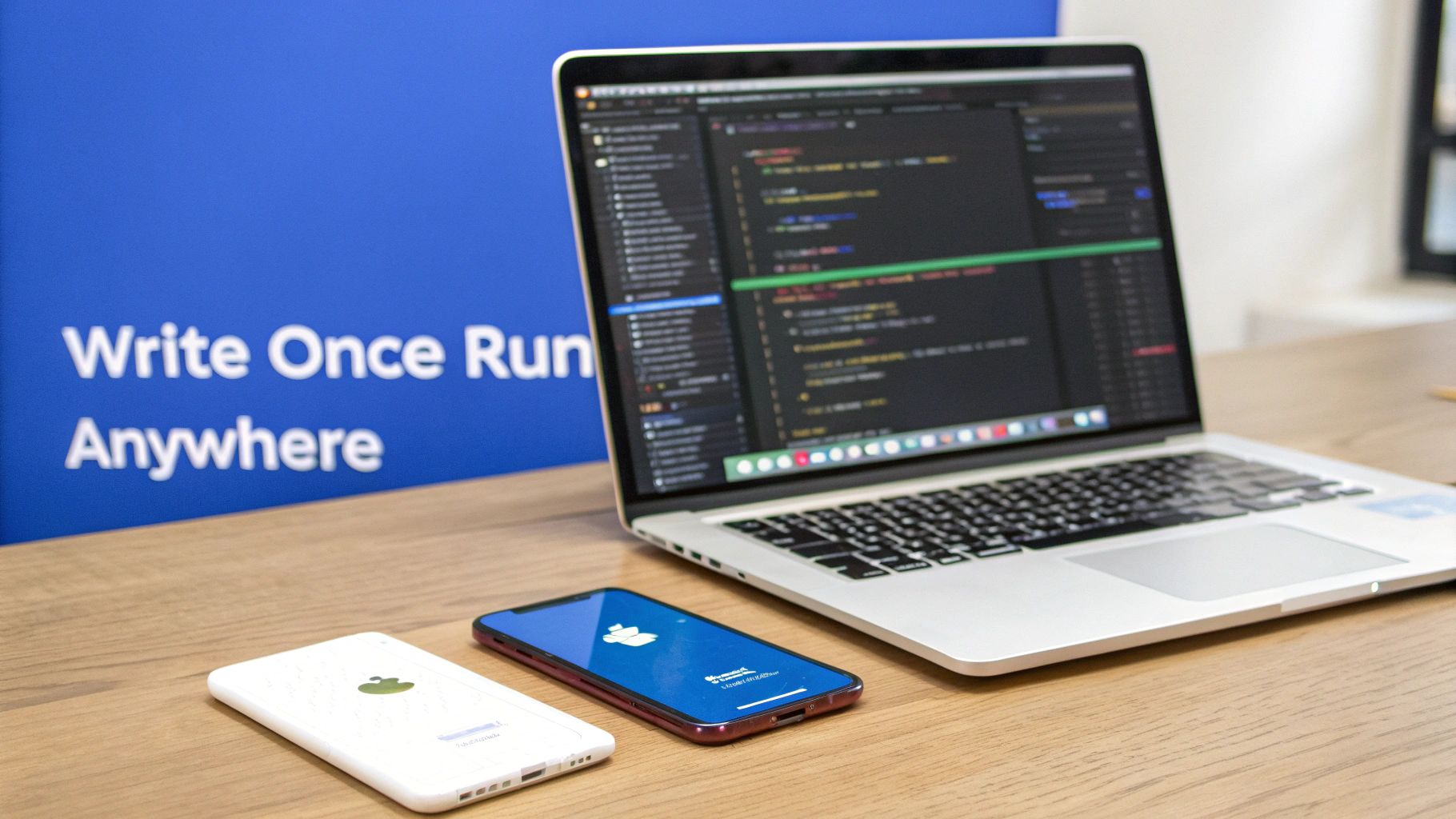
Let’s try a simple analogy. Say you need to give the same instructions to two people, but one only speaks English and the other only speaks Spanish. The traditional way—what we call native development—is like learning both languages fluently and delivering the message separately. It works, but it’s incredibly time-consuming and requires specialized skills for each language.
Cross-platform development offers a much smarter path. Instead of becoming fluent in two languages, you write the instructions in a common language. A skilled translator—in this case, the cross-platform tool—then perfectly conveys your message to both people. This is the heart of the "write once, run anywhere" philosophy.
The game-changing benefit here is maintaining a single codebase. Instead of wrestling with two separate projects, each with its own team, bugs, and update schedules, you get to manage just one. This unified approach unlocks some serious wins:
The core value is simple: reach the biggest possible audience with the least amount of repeated work. By building from one set of code, you slash development time and costs, often by nearly half.
This push for efficiency has lit a fire under the market. The global industry for these frameworks is on track to hit $50 billion in 2025, and it’s growing fast. This boom is a direct result of businesses needing a cost-effective way to get in front of both iOS and Android users.
Just look at the numbers. In 2024, roughly 28% of new apps on the iOS App Store were built with Flutter. When you can reuse 60-80% of your code, this approach stops being just a technical choice and becomes a powerful strategic move. You can learn more about the explosive growth of cross-platform frameworks and see why so many teams are making the switch.
When you start digging into the world of cross platform app development tools, you'll hear two names come up over and over again: Flutter and React Native. These aren't just popular; they're the titans of the industry. Backed by Google and Meta, respectively, thousands of companies trust them to build their apps.
Choosing between them isn't about finding a clear "winner." It's more about understanding their core philosophies to see which one is the right fit for your project's DNA.
Industry trends show a pretty tight race. In 2024, Flutter is used by about 42% of developers, just edging out React Native at 38%. This isn't just a popularity contest; it reflects a real demand for tools that can deliver slick performance and a great user experience. Big names like BMW and Alibaba are all in on these frameworks, building beautiful, consistent apps for their users—a trend you can learn more about with these insights on iOS app development statistics. This friendly rivalry is great for us developers, as it pushes both platforms to constantly innovate and roll out more powerful features.
The biggest difference between Flutter and React Native comes down to how they draw things on the screen. A good way to think about it is like a painter creating a masterpiece on a blank canvas versus an architect using pre-fabricated building blocks.
Flutter is the painter, wielding total control over a digital canvas. It ships with its own high-performance rendering engine, Skia, to draw every single pixel on the screen. This means a button, a slider, or a line of text will look exactly the same on a brand-new iPhone as it does on a five-year-old Android.
This approach gives you incredible control and consistency. Teams that want pixel-perfect designs, intricate brand expressions, and fluid animations often lean towards Flutter. The BMW app is a perfect example; it uses Flutter to deliver a premium, visually stunning interface that feels the same everywhere, reinforcing the brand's high-end identity.
React Native, on the other hand, is the architect. Instead of drawing its own UI from scratch, it acts as a go-between, using a "bridge" to tell the phone's operating system to show its own native UI components. A button in a React Native app isn't a custom graphic; it's the actual native iOS or Android button.
This method is fantastic for ensuring an app’s look and feel perfectly match the platform's conventions. Users appreciate this because the app behaves just like every other app on their phone. Instagram is a classic example—it feels completely at home on both iOS and Android because it’s built with the native building blocks users are already familiar with.
The programming languages they use are another key differentiator. React Native is built on JavaScript, one of the most widely-used languages on the planet. This is a huge plus because millions of web developers can jump into mobile development without a steep learning curve.
Flutter chose a different path, using a language called Dart. While not as common as JavaScript, Google specifically designed Dart for building user interfaces. It’s strongly typed and compiles directly to native machine code, which often leads to smoother animations and zippier startup times.
The choice often boils down to this: do you want to tap into your team's existing JavaScript skills with React Native, or are you willing to invest in learning Dart for the performance gains and total UI control Flutter offers?
To lay it all out, let's look at a head-to-head comparison.
Here’s a breakdown of how the two frameworks stack up against each other on the most important features.
| Feature | Flutter | React Native |
|---|---|---|
| Language | Dart | JavaScript |
| UI Rendering | Custom rendering engine (Skia) | Uses native UI components |
| Performance | Compiles to native code; often faster for animations | Uses a "bridge" which can sometimes create bottlenecks |
| UI Consistency | Pixel-perfect consistency across all platforms | Adheres to platform-specific look and feel |
| Developer Pool | Smaller but growing; requires learning Dart | Huge; taps into the massive JavaScript community |
| Ideal For | Visually rich apps, brand-centric designs, complex animations | Apps needing a native look, projects with existing web teams |
So, what's the verdict? Ultimately, both are incredible cross platform app development tools. React Native is a powerhouse for creating apps that feel deeply integrated with the native platform, making it a go-to for social media and e-commerce. Flutter truly shines when brand identity and a unique, custom user experience are the top priorities, making it a favorite for design-forward applications.
The promise of writing code once and deploying it everywhere is a powerful one, but choosing cross platform app development tools always involves a bit of a balancing act. No single solution is a silver bullet for every project, and getting real about the potential limitations is the first step to making a smart decision.
Think of it like choosing between a versatile multi-tool and a dedicated wrench. The multi-tool is a lifesaver—it’s convenient and handles most jobs just fine. But when you need to apply serious torque to a specific bolt, only the specialized wrench will do. Cross-platform frameworks are that multi-tool: incredibly flexible and efficient, but sometimes they can’t match the raw, specialized power of a purely native approach.
These compromises usually show up in three key areas: performance, user experience, and access to the latest device features.
This diagram gives a great high-level view of where popular frameworks like Flutter and React Native sit in the ecosystem.
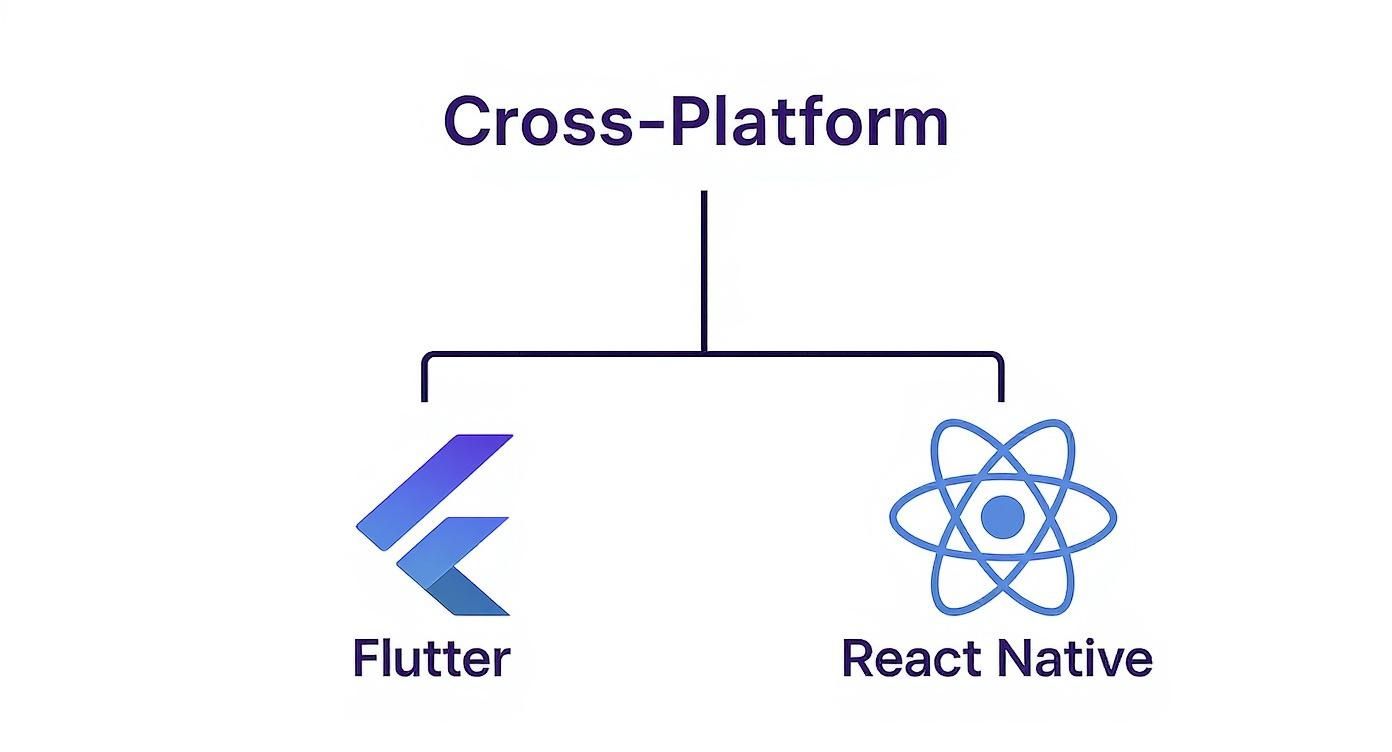
As you can see, even though both are "cross-platform," they take very different architectural paths to get you to the finish line.
Performance is probably the most talked-about trade-off. Let’s be clear: modern frameworks like React Native and Flutter are incredibly fast and deliver near-native speed for the vast majority of apps. Still, a small performance overhead can exist because of the abstraction layer that lets one codebase run on different operating systems.
In React Native, this layer is called the "bridge." It's the communication line between your JavaScript code and the native platform APIs. For most things, like UI updates and business logic, this communication is practically instantaneous. But if you’re building something graphically intense—a 3D game or a complex photo editor—the constant back-and-forth messaging across this bridge can occasionally create bottlenecks you wouldn't see in a 100% native app.
For the vast majority of apps—think e-commerce, social media, or productivity tools—this performance difference is negligible and often unnoticeable to the end-user. The trade-off only becomes critical in applications pushing the device's hardware to its absolute limits.
Next up is the user experience. iOS and Android users are creatures of habit; they have completely different design languages and expectations. An iPhone user instinctively knows certain swipe gestures and navigation flows, while an Android user is used to Material Design and the physical back button.
Cross-platform tools have to thread this needle carefully.
The trade-off is pretty straightforward. If you chase a perfect, platform-specific UX, you might find yourself writing more platform-specific code, which chips away at the "write once, run anywhere" dream. Go the other way with a one-size-fits-all UI, and you risk your app feeling slightly "off" to discerning users on one of the platforms.
Finally, there’s the question of accessing the very latest hardware features. When Apple or Google drops a new API—say, for a fancy new camera sensor or an advanced AR toolkit—native developers get day-one access.
For cross-platform frameworks, there’s usually a slight delay. The community or core team needs a little time to build a "wrapper" or module that exposes that new functionality to your shared codebase. This usually happens pretty quickly, but if your app's entire strategy depends on being first to market with cutting-edge hardware integrations, that small lag could be a factor.
For the basics, you're covered. Standard features like GPS, the camera, and accelerometers are fully supported right out of the box. This trade-off really only matters for the most specialized, hardware-driven apps.
Picking the right cross-platform app development tools isn’t just about a feature-by-feature comparison. It’s a strategic move that has to sync up with your business goals, your team's existing talent, and the specific needs of your project. Think of it less like finding the "best" tool on the market and more like finding the perfect key for a very specific lock.
Nailing this choice from the get-go saves you from painful, expensive pivots down the road. It makes the entire development process smoother and more efficient. To get it right, you need to balance the shiny tech with the practical, on-the-ground realities of your business.
Let’s be honest: the most powerful framework in the world is totally useless if your team can’t actually use it. The first, and most important, step is to take a hard look at the skills you already have in-house. A tool that plays to your team's strengths will always mean less time spent learning and more time spent building.
The whole point is to build on momentum, not start from a dead stop. Choosing a tool that fits your team's existing skills is the single biggest thing you can do to speed up your project.
Next, you have to get granular about what your app actually needs to do. Different frameworks are built for different things. Matching the tool to the job is everything. Not every project cares about the same things, so be brutally honest about your priorities.
Think about these common situations:
The market shows just how varied these needs are. Hybrid tools like Ionic and Cordova hold a massive 40.8% market share, showing that tons of teams prefer web-based approaches. But frameworks like React Native and Flutter are right behind them at 31.7%, typically chosen when near-native performance is a must. Knowing this landscape is crucial, and you can dig deeper into these trends and their impact on the mobile app economy.
Finally, look past the tool itself and check out the world built around it. A framework is only as good as its community. A buzzing ecosystem is your safety net, making sure you’re never stuck trying to reinvent the wheel.
When you’re sizing up a framework, ask yourself these questions:
Picking a tool with a thriving ecosystem means you’re not just getting a piece of tech; you’re joining a community that will help you solve problems, build faster, and make sure your project stays healthy for the long haul.

Picking the right framework is a massive step, but the real secret to moving fast is plugging into the ecosystem built around it. Smart teams know better than to build everything from scratch. They stand on the shoulders of pre-built solutions that handle all the repetitive, foundational work.
This approach lets you jump straight to building the unique, high-value features that will actually make your app stand out from the crowd.
The single most powerful accelerator you can find is a production-ready template. Don't think of these as just code snippets—they’re fully functional app skeletons. They give you a solid starting point for common app types, like social media feeds, e-commerce stores, or fitness trackers, saving you months of engineering effort.
By starting with a template, you get to bypass all the tedious setup for navigation, user authentication, state management, and basic UI. For a startup trying to get an MVP out the door, this strategy isn't just helpful; it's a game-changer.
Beyond full app templates, a rich ecosystem of companion tools can kick your workflow into high gear. Think of these tools as specialized assistants, each one tackling a specific part of the development process so your team doesn't have to reinvent the wheel.
This is where you find the resources that seriously boost productivity and keep your project consistent. The goal is simple: build faster without cutting corners on quality, all by using battle-tested components and services.
Plugging into a robust ecosystem isn't just a time-saver—it's about baking in best practices from the very beginning. These tools and templates are often built by experts and refined by a whole community, giving you a higher-quality foundation than you could probably build on your own under a tight deadline.
For teams using React Native, this ecosystem-first approach is incredibly powerful. Marketplaces like theappmarket.io offer a whole range of premium templates designed to get you 80% of the way to a finished product on day one.
Let’s say you're building a new meditation app. Instead of staring at a blank screen, you could start with a complete template that already has all of this built-in:
This completely transforms the development process. Your team’s focus shifts from building plumbing to innovating on your core idea—like creating unique guided meditations or advanced user analytics. When you combine a powerful framework with ready-made templates and tools, you can launch a polished, feature-rich app in a fraction of the time.
Even with all the obvious upsides, it's natural to have a few nagging questions when you're thinking about using cross-platform app development tools. Let's jump right into the big ones and clear things up so you can make the right call for your next project.
This is the classic question, and honestly, the "it depends" answer isn't very helpful. Here’s the real talk: modern frameworks like Flutter and React Native have come an incredibly long way. For most apps, the performance is so good that your users will never know the difference.
Think about e-commerce, social media, or productivity apps. The performance you get from a cross-platform tool is more than enough to deliver a buttery-smooth experience. The only time you might feel a pinch is with super-demanding stuff, like high-fidelity 3D games or apps doing heavy, real-time graphics processing. For those rare cases, native might still have a slight edge.
But let's be realistic. For over 95% of mobile apps out there, the performance from a top-tier cross-platform framework won't just meet user expectations—it will blow them away. You're trading a tiny, often unnoticeable performance dip for a massive boost in development speed.
The old "write once, run anywhere" slogan sounds amazing, but in practice, it’s more like "write once, tweak a little here and there." And that's still a huge win. Most development teams find they can share somewhere between 70% and 95% of their code between iOS and Android.
So, what about that other 5-30%? It usually comes down to a couple of things:
Even with these small adjustments, you're still saving a colossal amount of time and effort compared to building and maintaining two completely separate apps from scratch.
This is where cross-platform really shines. A single codebase massively simplifies your life down the road. Fix a bug once, and it’s gone on both platforms. Add a new feature, and you build it once. This is a game-changer for reducing long-term costs and headaches.
If there's a "hidden" cost, it's managing dependencies. You're counting on the framework's core team and the community to keep things updated for new operating systems and features. Thankfully, the major frameworks have a stellar track record. You just need to stay on top of framework updates to keep your project healthy and secure—which, let's face it, is just good practice for any software project.
Ready to build your next app faster without cutting corners on quality? theappmarket offers production-ready React Native templates that can speed up your development by up to 80%. Check out our full catalog and get started today.
Article created using Outrank
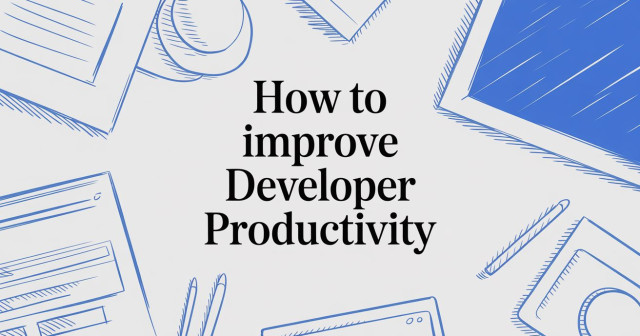
Nov 25, 2025

4 min read
Discover how to improve developer productivity with actionable strategies for workflow, tooling, and culture. A practical guide for software engineering teams.
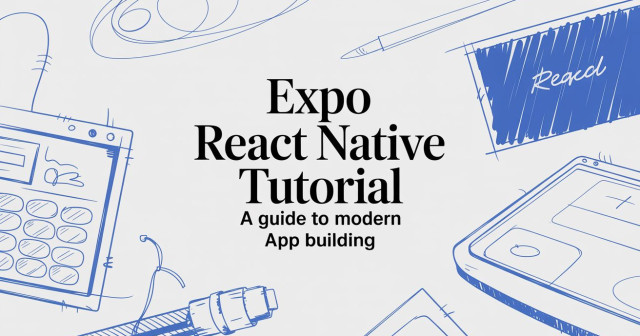
Nov 23, 2025

4 min read
This Expo React Native tutorial provides a hands-on guide to building cross-platform apps. Learn setup, styling with NativeWind, navigation, and deployment.
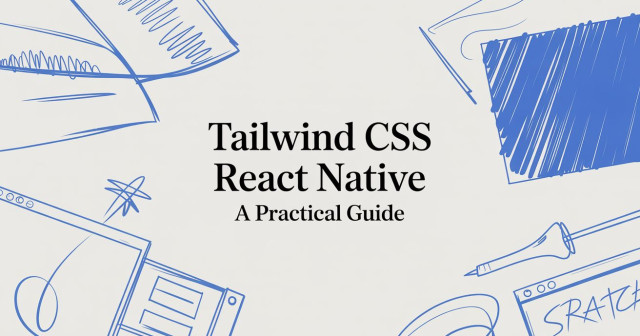
Nov 22, 2025

4 min read
Build beautiful UIs faster with this guide to Tailwind CSS React Native. Learn setup, styling, and advanced techniques with NativeWind for mobile apps.
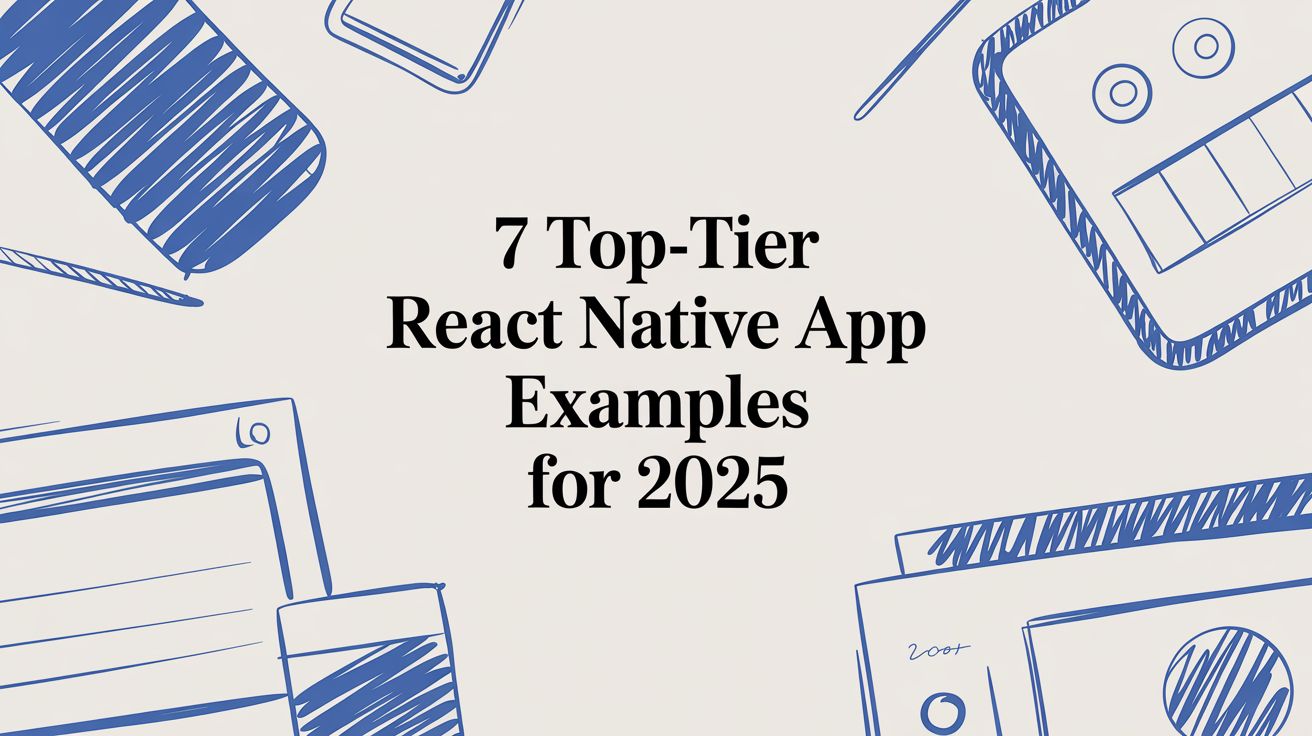
Nov 21, 2025

4 min read
Explore our curated list of 7 top-tier React Native app examples. Discover production-ready templates and resources to build your next app faster.